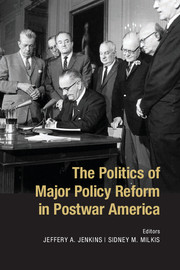Book contents
- Frontmatter
- Contents
- Contributors
- Acknowledgments
- 1 Introduction
- 2 The Long 1950s as a Policy Era
- 3 Regulation, Litigation, and Reform
- 4 Courts and Agencies in the American Civil Rights State
- 5 The Politics of Labor Policy Reform
- 6 Teachers Unions and American Education Reform
- 7 Progressive Federalism and the Contested Implementation of Obama’s Health Reform
- 8 Federalism and the Politics of Immigration Reform
- 9 Trade Politics and Reform
- 10 The Politics of Intelligence Reform
- 11 Follow the Leader
- 12 Conclusion: Madison Upside Down
- Index
- References
10 - The Politics of Intelligence Reform
Published online by Cambridge University Press: 05 November 2014
- Frontmatter
- Contents
- Contributors
- Acknowledgments
- 1 Introduction
- 2 The Long 1950s as a Policy Era
- 3 Regulation, Litigation, and Reform
- 4 Courts and Agencies in the American Civil Rights State
- 5 The Politics of Labor Policy Reform
- 6 Teachers Unions and American Education Reform
- 7 Progressive Federalism and the Contested Implementation of Obama’s Health Reform
- 8 Federalism and the Politics of Immigration Reform
- 9 Trade Politics and Reform
- 10 The Politics of Intelligence Reform
- 11 Follow the Leader
- 12 Conclusion: Madison Upside Down
- Index
- References
Summary
The Intelligence Reform and Terrorism Prevention Act (IRTPA) is “the most dramatic reform of our nation’s intelligence capabilities since President Harry S. Truman signed the National Security Act of 1947,” remarked President George W. Bush when signing the legislation on December 17, 2004. He was right. Although the effectiveness of IRTPA remains to be determined, the legislation’s intent was ambitious and far-reaching.
Bush left unmentioned that most of IRTPA’s initiatives had been proposed previously – and repeatedly. Intelligence reform has been a recurrent theme on Capitol Hill since the establishment of the Central Intelligence Agency (CIA) at the outset of the Cold War. Over the subsequent sixty-five years, approximately twenty commissions, committees, and panels recommended improvements to the structure, mission, and operations of the CIA and other components of the intelligence community (IC). Prescriptions to strengthen community management in order to enhance coordination and integration among the disparate elements, a linchpin of IRPTA, which a historian in the Office of the Director of National Intelligence described as the “unfinished business of 1947,” were common and frequent. So, too, were proposals to promote information sharing and eliminate stovepipes, fortify congressional oversight, redistribute the budget and make it more transparent, improve the relationship between intelligence producers and consumers at all levels and between the foreign and law enforcement communities, and address other fundamental problems. These proposals received serious attention and often the support of experts and veteran officials. In almost all cases until 2004, nevertheless, those with the capacity to enact or institute major reforms either rejected the recommendations or gravely diluted them. Even the impact of IRTPA, contemporary evidence suggests, will be less transformative than its proponents intended, and many close observers of and commentators on America’s national security architecture argue is necessary.
- Type
- Chapter
- Information
- The Politics of Major Policy Reform in Postwar America , pp. 227 - 252Publisher: Cambridge University PressPrint publication year: 2014
References
- 1
- Cited by



